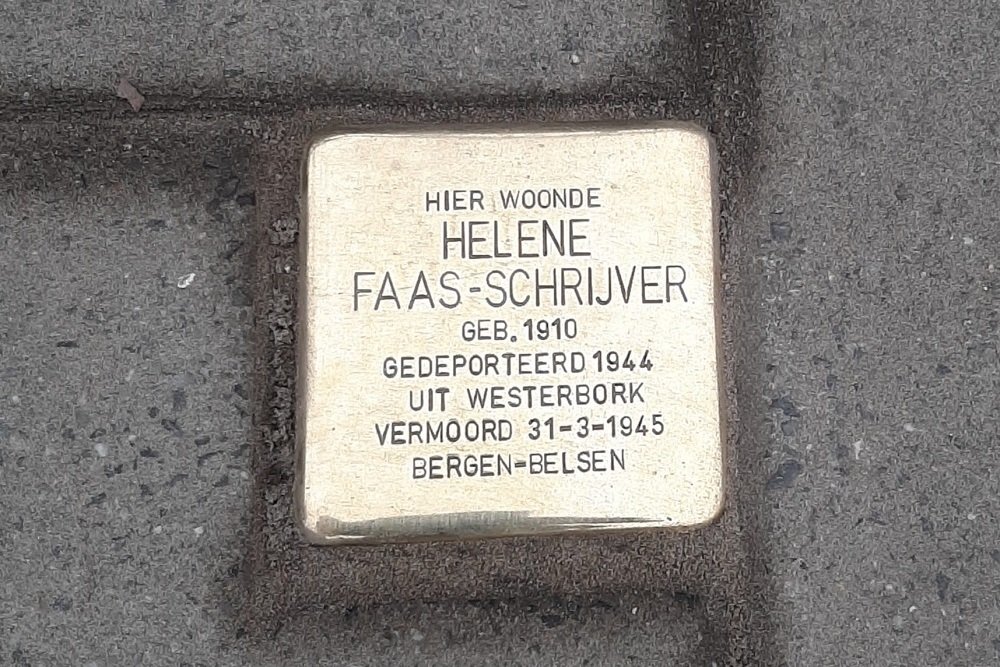Stumbling Stone Hyacintenlaan 14
This memorial stone (so called Stolpersteine of stumbling blocks) commemorates:
Helene Faas-Schrijver
The small copper plaques, in the pavement in front of houses of which the (mostly Jewish) residents were murdered by the Nazis, mention the name, date of birth and place (mostly a concentration camp) and date of death.
In many other cities, mainly in Germany but also in other European countries, the memorials also can be found. There are already many thousands of these plaques and their number is still counting. Almost all Stolpersteine are laid by the German artist himself, Gunter Demnig.
HELENE FAAS WRITER
April 23rd, 1910 (Amsterdam) - March 31st, 1945 (Bergen-Belsen)
HYACINTHEN AVENUE 14 BLACK
Helene Schrijver (known as Leni) was born on April 23, 1910 in Amsterdam as the daughter of the merchant Barend Abraham Schrijver and Ida Eva Schaap. Eighteen months later, on October 31, 1911, her little brother Maurits was born. On November 8, 1933, Helene married in Haarlem office clerk Arie Hermanus Faas, born July 17, 1896 in Amsterdam, but living in The Hague at the time of the marriage. Their only son Henri Arie Faas (Hans) was also born on January 26, 1936 in The Hague. Father and child survived the war.
In 1938 the marriage was dissolved. Helene was still officially living in The Hague at the time, but stayed in Haarlem at Hyacinthenlaan 14-zwart. In that year she worked as an office clerk.
Probably in September 1942, Helene and her brother Maurits went into hiding in Amsterdam with Elisabeth (Betsy) Brinkhuis on the Staringstraat. The hiding place was betrayed and at the beginning of October 1943 both were transferred to the Hollandsche Schouwburg on the Plantage Middenlaan. From there Helene was transferred to the prison on the Amstelveenseweg in Amsterdam. Her brother Maurits managed to escape and survived the war.
On 26 November 1943, Helene was taken to camp Vught, where she worked at the Philips industrial workshop. From camp Vught she was taken via camp Westerbork to Theresienstadt and from there on 6 October 1944 to Auschwitz. At the beginning of January 1945 she was transferred to the Gross-Rosen camp in Silesia and shortly before the arrival of the Red Army in February of that year to the Bergen-Belsen camp, where, according to official records, she died of typhus on 31 March 1945. Only about two weeks later, on April 15, 1945, Bergen-Belsen was liberated by the British.
Transport from Westerbork 31 July 1944. Died in Bergen-Belsen 31 March 1945.
She was 34 years old.
Do you have more information about this location? Inform us!
Source
- Text: Reini Elkerbout
- Photos: Reini Elkerbout
Nearby
Museum
Point of interest
- NSVO District Office North Holland - Overveen
- Regional Quarter Nationale Jeugdstorm - Haarlem
- Former House of Hannie Schaft, Haarlem - Haarlem
Monument
- Memorials Bankers of the Resistance - Bloemendaal
- Stubling Stones Rollandslaan 21 - Haarlem
- Memorial Old Bavo School - Haarlem
Cemetery
- Dutch War Graves General Cemetery Kleverlaan - Haarlem
- Commonwealth War Grave General Cemetery Kleverlaan - Haarlem
- Dutch War Graves Roman Catholic Cemetery St. Barbara - Haarlem
Remembrance Stone
- Stumbling Stones Emmalaan 30 - Haarlem
- Stumbling Stones Hoofmanstraat 22 - Haarlem
- Stumbling Stone Prinsesselaan 29 - Haarlem
Fortification
- FLAK Stand Haarlem - Haarlem
- Atlantikwall - Regelbau 610 - Bloemendaal
- Atlantikwall - Vf Beobachter - Bloemendaal





